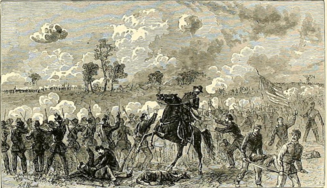Battle of Baton Rouge (1862)
[4] On April 25, 1862, the day before New Orleans fell to the US Navy fleet under Admiral David Farragut, the Confederate state government decided to abandon Baton Rouge, moving first to Opelousas, and then to Shreveport.On May 9, Navy Commander James S. Palmer of the federal gunboat USS Iroquois landed at the town wharf and took possession, without resistance, of the Pentagon Barracks and the arsenal.During the summer, Major General Earl Van Dorn, commander of Confederate forces east of the Mississippi, resisted a Union bombardment of Vicksburg.The Confederate ironclad ram Arkansas had come down the Yazoo River, inflicting damage on the unprepared Union fleet as she passed through, and was anchored in Vicksburg.Her commander ordered Arkansas set afire to prevent her capture.Without any prospect of naval support, Breckenridge was unable to attack the Union positions and withdrew.The "Battle of Baton Rouge Commemorative Ceremony" is held every year on the first Saturday in August in and around Magnolia Cemetery, sponsored by the Foundation for Historical Louisiana.




Battle of Baton Rouge (1779)Trans-Mississippi TheaterAmerican Civil WarHarper's WeeklyBaton Rouge, LouisianaUnited StatesConfederate StatesThomas R. WilliamsDavid D. PorterJohn C. BreckinridgeCharles ClarkDaniel RugglesCharles W. Read1st DonaldsonvilleEast Baton Rouge ParishLouisianaConfederateNew OrleansDavid FarragutBaton RougeOpelousasShreveportJames S. PalmerUSS IroquoisPentagon BarracksHartfordThomas WilliamsEarl Van DornMississippiVicksburgArkansasYazoo RiverCamp MooreComite RiverMagnolia CemeteryUSS EssexPort HudsonDepartment of the Gulf9th Connecticut Infantry21st Indiana Infantry14th Maine Infantry30th Massachusetts Infantry6th Michigan Infantry7th Vermont Infantry4th Wisconsin InfantryUSS HartfordUSS WestfieldUSS JacksonUSS CayugaUSS KatahdinUSS BrooklynUSS CliftonUSS SciotaUSS KineoUSS EssexBenjamin H. Helm4th Kentucky9th KentuckyFrancis M. Walker15th Mississippi19th Tennessee20th TennesseeThomas B. Smith28th Tennessee45th TennesseeJoseph H. Lewis3rd Kentucky6th Kentucky7th KentuckyHenry W. Allen4th Louisiana12th LouisianaThomas M. ScottJohn S. Bowen1st Missouri9th Arkansas10th ArkansasCSS Arkansas21st IndianaWinters, John D.Louisiana in the American Civil WarLouisiana secessionConfederacyVicksburg campaignRed River campaignMississippi River in the American Civil WarAnaconda PlanBattle of the Head of PassesBattle of Forts Jackson and St. PhilipCapture of New OrleansBattle of Donaldsonville IBattle of Georgia LandingBattle of Fort BislandBattle of Irish BendBattle of Vermilion BayouBattle of Plains StoreSiege of Port HudsonBattle of Milliken's BendBattle of LaFourche CrossingBattle of Donaldsonville IIBattle of Goodrich's LandingBattle of Kock's PlantationBattle of Stirling's PlantationBattle of Bayou BourbeuxGrand CoteauBattle of Fort DeRussyBattle of Henderson's HillBattle of MansfieldBattle of Pleasant HillBattle of Blair's LandingBattle of Monett's FerryAction of 26–27 April 1864Actions near AlexandriaBattle of Calcasieu PassBattle of MansuraBattle of Yellow BayouP.G.T. BeauregardAlbert G. BlanchardBraxton BraggRandall L. GibsonHenry GrayHarry T. HaysSt. John LiddellAlfred MoutonFrancis T. NichollsLeroy A. Stafford